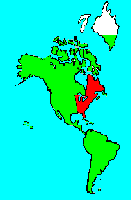SPECIES INFO
Carpenter frog (Rana virgatipes) is found from New Jersey south to northern Florida. This is a coastal plain species. Carpenter frog is a medium small frog with a 1 1/2 to 2 1/2 inch body. The two lateral lighter stripes help identify this species.Rana genus (true or typical frogs) is found widely in the Old World. There are about 270 different species in this genus. About twenty-two of these species are found in North America.
True frog group (Ranidae family) are found throughout the world. The largest genus in this family is the Rana genus with over 250 species. These animals begin life as tadpoles, and after a length of time turn into adult frogs. The adults usually live close to water, and feed mostly on insects. The diet of larger species include small mammals and birds. There are about 667 species in this family.
In 2011 in his excellent book on Frogs and Toads of the World Chris Mattison notes that this family has been divided into several different new families. The new limited Ranidae contains only 342 species. The new limited genus Rana contains only 49 species.
The added families (as accepted by Chris Mattison)in alphabetical order are Dicroglossidae(170), Micrixalidae(11), Nyctibatrachidae(17), Phrynobatrachidae(80), Ptychadenidae(53), Pyxicephalidae(68).
The fanged frogs (Dicroglossidae)with 180 species are native to the Old World tropics from Africa to New Guinea.
The Indian torrent frogs (Micrixalidae) with 11 species is found in south west India.
The robust frogs (Nyctibatrachidae) with its 17 species is found from southern India to Sri Lanka.
The African puddle frogs (Phrynobatachidae) with its 80 species are native to Africa south of the Sahara.
African Grass frogs (Ptychadenidae) with 53 species are found in the Afreican region including Madadascar and nearby islands.
African ex-Ranidae frogs (Pyxicephalidae) with its 68 species are found only in Africa south of the Sahara.
Order Anura contains the jumping amphibians such as the frogs and the toads. Chris Mattison in Frogs and Toads of the World published in 1992 gives a very good overview of this group of amphibians. He states that there are 3,445 species in 310 different genera that he believes should fall into 21 different families. The three largest families, in terms of species, are the Ranidae (Typical frogs) with 667 species, the Hylidae (tree frogs) with 630 species, and the Leptodactylidae (small to medium Neotropical frogs) with 710 species. The Bufonidae (true toads) has 335 species.
In 2011 Chris Mattison published a new work under a similar title that appears slightly different by different publishers. In this book he states that the number of species of frogs and toads in the world is now at 5,858. However, he further notes that this group of animals is in serious trouble on a world wide basis. He notes that in 2008 the IUCN noted that 398 species were critically endangered (with 37 of those probably extinct), 650 endangered, and 578 vulnerable.
Amphibians (Class Amphibia) are best known as the frogs, toads, and salamanders. Amphibians begin their life as larvae that live in the water. Some species continue to evolve so that the final forms can breathe air. A typical example, is the Bullfrog of North America that begins life as a tadpole, and then finally turns into a adult frog. Amphibians usually have a soft, moist skin, and four legs adapted for walking or jumping or climbing. They have a three-chambered heart which gives them a fairly advanced circulatory system. There are probably about 2,500 species in this class.
Backboned Animals (Phylum Chordata) are the most advanced group of animals on earth. These animals are characterized by having a spinal cord or backbone. Most members have a clearly defined brain that controls the organism through a spinal cord. Fish, amphibians, reptiles, birds, and mammals are in this phylum.
Currently, some taxonomists believe that the fish should be divided into two groups (sharks and regular fishes) and that there are some other primitive groups in the phylum such as hagfish or lampreys.
Animal Kingdom contains numerous organisms that feed on other animals or plants. Included in the animal kingdom are the lower marine invertebrates such as sponges and corals, the jointed legged animals such as insects and spiders, and the backboned animals such as fish, amphibians, reptiles, birds, and mammals.


